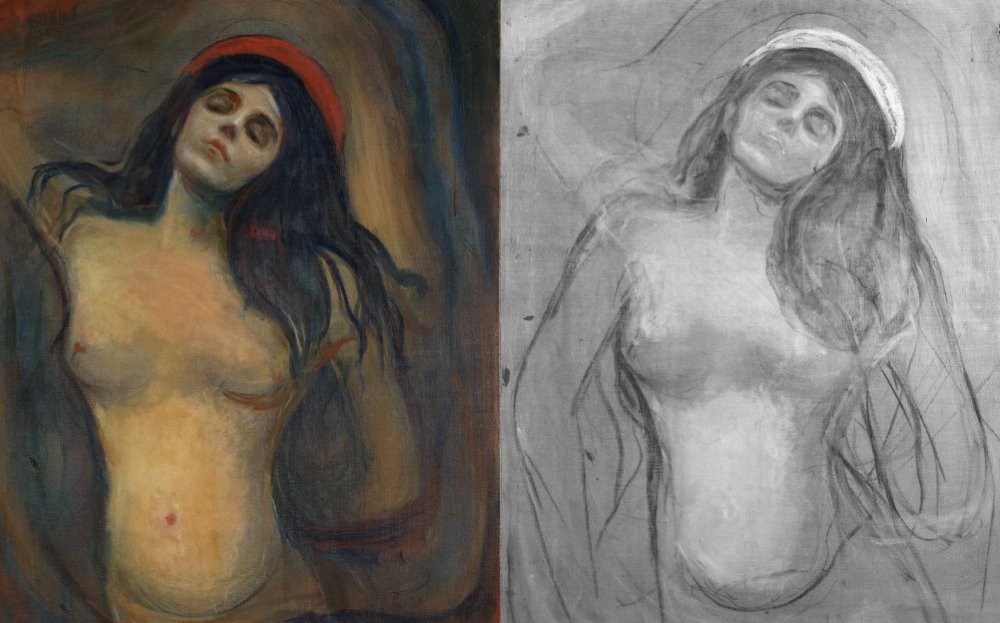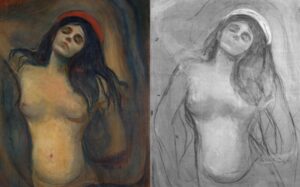
Hidden Sketch Reveals a More Traditional Version of Edvard Munch’s Sensual ‘Madonna’

Edvard Munch’s Madonna toes the line between sensational and spiritual. One of the Norwegian artist’s most controversial paintings, the 1894 work depicts a naked woman arching her back, long dark hair spilling down her shoulders as she raises one arm and stretches the other behind her back.
The woman’s posture communicates erotic ecstasy. But new images of the painting’s hidden underdrawings reveal that Munch initially sketched his nude subject in a more traditional pose, reports Dalya Alberge for the Observer.
Photographer Børre Høstland and curator Thierry Ford, both of Norway’s Nasjonalmuseet, or National Museum, discovered the sketch during a routine conservation checkup, reports Taylor Dafoe for Artnet News. The pair used infrared reflectography, a noninvasive photography technique, to peer beneath layers of oil paint.
“We can see that [Munch] experimented with letting both arms hang down,” says Vibeke Waallann Hansen, a curator at the National Museum, in a statement. “Along with other early sketches with similar motifs, the underdrawings in the painting tell us that he was hesitant about how to place the arms of his Madonna.”
Speaking with the Observer, the curator calls the find “really exciting.”
“You can see how Munch was working,” says Waallann Hansen. “The underdrawing shows that the first position he tried was a more traditional way of presenting a woman, more in line with portraits. The final pose was more innovative.”
In her final form, the woman’s raised arms add another element of ambiguity to the composition, which conflates the sacred and sexual in ways that offended some of Munch’s contemporaries. Though Munch officially titled the work, Madonna, he also sometimes referred to it as Woman Making Love. In place of the gold halo associated with the Christian Virgin Mary, the artist’s subject sports a halo of crimson red.
“Is she standing? Or is she lying down? What is the background? Is it water or light? Or a kind of atmosphere?” Waallann Hansen asks the Observer. “Munch was first thinking of having her arms behind her back, which looks more like she’s standing. With the position he ended up with, he introduced more ambiguity.”
When Munch first displayed Madonna in Kristiania (now Oslo) in 1895, conservative audiences responded with shock to its frank depiction of a woman having sex. The fierce debate about the morality of the image ensued notes the museum in the statement.
Munch, for his part, liked the composition so much that he reproduced it in four similarly sized paintings between 1894 and 1897. According to the Oslo-based Munch Museum, the artist mounted at least one version of Madonna in a custom wooden frame painted with swimming sperm and a small fetus. He also wrote a short text inspired by the image:
The pause when the whole world stopped in its tracks
Your face encompasses all of the earth’s beauty
Your lips red like ripening fruit
separate as though in pain
The smile of a corpse
Now life offers death its hand
The chain has been linked which connects
The millennium of generations
That are deceased to the millennium of generations that are to come.In addition to the five paintings, Munch created hundreds of impressions of a Madonna lithograph, each surrounded by a decorative border of sperm. The print became “one of his bestsellers,” according to the Munch Museum. As Lilias Wigan wrote for Country Life in 2019, the artist changed the lithograph’s composition at least once, making the woman’s locks of hair curl toward her stomach in a 1913 print.
Høstland and Ford’s find helps clarify the timeline of Madonna’s creation. Because Munch was evidently still finalizing his composition before he set it down in paint, it’s “reasonable” to assert that the National Museum’s version of Madonna is the earliest of the five known copies, Waallann Hansen argues in the statement. That would place the work’s completion around 1894.
The canvas has been housed in the national collections since 1909. When the new National Museum building opens in June 2022, the canvas will be displayed in a room dedicated to Munch’s oeuvre.
Madonna was far from the only controversial work produced by Munch during his lifetime. When he first showed his most famous work, The Scream (1893), to the Oslo public in 1895, one art critic decried it as an indication that one could no longer “consider Munch a serious man with a normal brain”—a slight that referenced the artist’s well-documented family history of mental and physical illnesses.
These comments might have inspired Munch to inscribe a strange bit of graffiti in the top left corner of The Scream, researchers announced in February. Translated from Norwegian, the tongue-in-cheek message reads, “Could only have been painted by a madman!”
(smithsonianmag.com)


